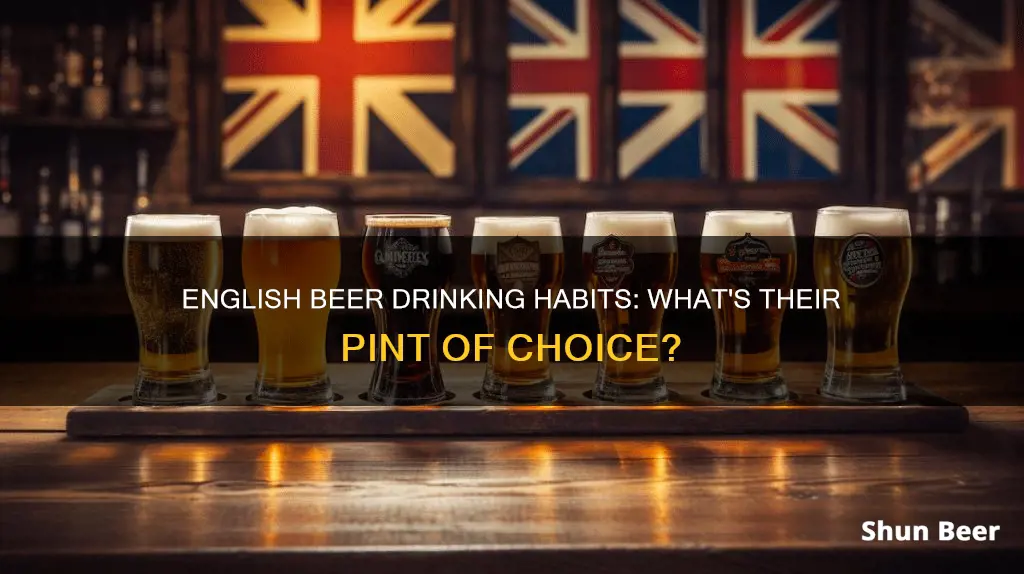
Beer has been brewed in England for thousands of years, and the country is known for its top-fermented cask beer, or real ale. English beer styles include bitter, mild, brown ale, old ale, stout, porter, and India pale ale. Lager has also increased in popularity since the mid-20th century.
English beer culture is as much about the culture of cask ale and the pub as it is the beer itself. Brits are never far from a beer, and going down to the pub with mates or having a pint with colleagues after work is an essential part of British life.
| Characteristics | Values |
|---|---|
| Brewing history | Brewing has been a part of English culture for thousands of years. |
| Beer styles | Bitter, mild, brown ale, old ale, stout, porter, India pale ale, lager, real ale, cask ale, craft beer |
| Beer temperature | Brits drink their ales at room temperature. |
| Beer carbonation | Beer is served without artificial carbonation. |
| Beer foam | British people don't like a big foamy head on a glass of beer. |
| Beer glass | Beer is served in pint and half-pint glasses. |
What You'll Learn

The history of English beer
During the Middle Ages, beer was one of the most common drinks and was consumed daily by all social classes in northern and eastern Europe, where grape cultivation was difficult or impossible. In England, per capita consumption was 275-300 litres a year by the Late Middle Ages, and beer was drunk with every meal. Alewives, or "brewsters", would put out an "ale-wand" to show when their beer was ready. Men eventually got involved in brewing and organised themselves into guilds, such as the Brewers Guild in London, which was formed in 1342.
In the 15th century, hops were introduced to the brewing process in England, creating a distinction between unhopped ale and hopped beer. Porter was one of the first beers to be produced at an industrial scale and became popular among working-class Londoners. India Pale Ale (IPA), heavily hopped to survive the journey to South Asia, marked the beginning of a global beer trade.
In the 18th century, a popular new style of dark beer called porter emerged in London. It was the first beer to be aged at the brewery and dispatched ready to drink. The development of rail links to Liverpool enabled brewers to export their beer throughout the British Empire.
In the 19th century, a typical brewery produced three or four mild ales, usually designated by a number of Xs, with the weakest being X and the strongest XXXX.
The 20th century saw the rise of lager, which became increasingly popular from the mid-20th century onwards. The temperance movement, along with World War I emergency measures, led to higher beer taxes and alcohol content limits. By the 1960s, industrial mega-breweries dominated the British beer market, and Brits also developed a taste for beers from continental Europe.
In response to the proliferation of sub-par brews, the Campaign for Real Ale (CAMRA) was formed in 1971 to promote traditional unpressurised beer. Today, British beer drinkers are spoiled for choice, with a range of options including high-volume convenience beers, real ales, and craft brews.
Beer and Painkillers: Mixing Tylenol and Alcohol
You may want to see also

Where do the English drink their beer?
The English have been brewing and drinking beer for thousands of years, and the pub is a national institution.
In the past, pubs were segregated by class and gender, with women and the upper classes relegated to the parlour, and working-class men gathering in the vault. Today, pubs are more democratic spaces, but they still vary in terms of their atmosphere and clientele.
The City Pub
City pubs attract people who work nearby and tend to be noisy and bustling. They are often crowded with groups of workmates at lunch and after work.
The Theme Pub
Theme pubs are a subcategory of city pubs, rarely found outside of big towns and cities. They cater to specific interests, such as goth, jazz, comedy, or rock.
The Country Pub
Country pubs are often what people imagine when they think of a traditional English pub: a cosy space with a warm, fire-lit interior. However, this image may be disappointed by the presence of slot machines and a microwave menu.
The Destination Pub
A subcategory of the country pub, destination pubs are those that people will travel miles to visit, often for the food, beer garden, character, or history.
The Local Pub
Local pubs are very local and may not be welcoming to out-of-towners. If you find yourself in a local, expect to be sized up by the regulars.
The Freehouse
Freehouses are independent pubs that are not tied to a brewery and can serve any beers and drinks they like. They are becoming rarer but can still be found across the country.
The Chain Pub
Chain pubs can be found in big train stations, shopping malls, and town centres. They tend to be standardised and lack character, but they do offer mass-market fare at varying levels of quality.
The Pub and the Home
In recent years, drinking at home has become more popular, with alcohol consumption outside of pubs doubling between 1960 and 1980. This shift has been driven by the popularisation of wine, which is mostly drunk at home, and by the rise of female drinkers, who were historically excluded from pubs.
The Future of Pubs
Despite the enduring popularity of pubs, about 30 are closing per week. However, this decline is being countered by the rise of craft beer outlets, chain pubs like Wetherspoons, and the micropub movement.
Chugging 30 Beers: A Dangerous Day-Long Binge
You may want to see also

Popular English beer styles
English beer styles include bitter, mild, brown ale, and old ale. Stout, porter, and India pale ale (IPA) were also originally brewed in London. Lager increased in popularity from the mid-20th century.
Bitter
Bitter is a well-hopped pale ale, ranging in strength from 3.5% to 7% ABV and in colour from pale gold to dark mahogany. The term originated in the 19th century when drinkers used "bitter" to refer to the sharper and hoppier versions of pale ales, in contrast with the milder, less hoppy versions that were prevalent at the time. Today, bitter is divided into three recognised styles: standard or ordinary bitter, best, special, or premium bitter, and extra special or strong bitter (also known as ESB).
Mild
Mild ales tend to be brown in colour and served on draft. They are malty beers with little hoppiness and a fruity yeast flavour. In the late 1800s, mild was a strong, cheap, fresh pub drink, frequently exceeding 6% ABV. However, due to wartime restrictions in the 1900s, mild took its current form as a low-alcohol beer, typically ranging from 3% to 4.5% ABV.
Brown Ale
English brown ales are similar in flavour and composition to darker versions of mild. Northern English brown ales, such as Newcastle, tend to be drier and stronger than dark milds, with a caramel, nut, and dried fruit malt flavour. They usually have an ABV of 4% to 5.5%.
Old Ale/English Barley Wine
Old ales and barley wines are strong, sweet beers with nutty and toffee-like malt flavours. They are often aged prior to release, which results in sherry and leathery notes. Old ales tend to have an ABV of 4.5% and above, while barley wines are typically stronger, ranging from 6% to 10% ABV.
Stout
Stout is closely related to porter, with a particularly bitter taste created by roasting barley. It is black in colour and has a creamy head. ABV can range from 4% up to 8%. Examples of stout include Irish dry stout (e.g. Guinness), oatmeal stout, and milk stout.
Porter
Porter is a historically significant style of beer that originated in 18th-century London. It is the ancestor of stout, with a maltier flavour and usually a black or dark brown colour. English porters tend to have an ABV of 4% to 6%. Variations include brown porter, robust porter, and Baltic porter.
Veterans Day: Beer and Celebration
You may want to see also

The most popular English beer brands
English beer is a broad church, encompassing a wide variety of styles and flavours. From bitter to mild, brown ale to old ale, and stout to porter, there's something for everyone. And that's before you even get to the ever-popular India Pale Ale (IPA).
While the craft beer scene has exploded in recent years, with microbreweries and small-batch beers taking off, lager remains the most popular style in Britain. And when it comes to the most popular beer brands, a few names crop up time and again.
BrewDog
One of the most recognisable names in the craft beer scene, BrewDog was founded in Scotland in 2007 and has since become one of the biggest beer brands in the UK. Its flagship beer, Punk IPA, is widely available in pubs, bars and shops across the country.
John Smith's
A name synonymous with English beer, John Smith's has been brewing since 1847. Its Newcastle Brown Ale is one of the most popular brown ales in the country and is exported around the world.
Molson Coors
Another big player in the British beer market, Molson Coors owns a host of popular brands, including Carling, the UK's best-selling beer. Brewed in Burton-upon-Trent, it accounts for one in every eight pints drunk in the UK.
Samlesbury's
Samlesbury's is the name behind Boddingtons Pub Ale, a bitter with a strong malt flavour and a distinctive creamy head. It's a popular choice in pubs across the country and is also available in bottles.
Shepherd Neame
Founded in 1698, Shepherd Neame is Britain's oldest brewer. Its Bishops Finger beer is a strong, dark ale with a distinctive flavour that has proven popular with drinkers for generations. The company also brews a range of other beers, including lagers and IPAs.
Tennent's
A Scottish lager with a cult following, Tennent's is known for its distinctive red-and-white can and no-nonsense, straightforward flavour. It's a popular choice for those looking for a refreshing, easy-drinking beer.
Guinness
While it may be an Irish brand, Guinness is hugely popular in England, where it is widely available on tap. This stout has a particularly bitter taste, created by roasting barley, that is offset by a creamy head.
Carling
Carling, from both British and Canadian origin owned by the American/Canadian brewing giant Molson Coors Brewing Company, is the best-selling beer in Britain and is mainly brewed in Burton upon Trent.
Heineken
The largest brewery in the UK today, Heineken which has three main breweries at (Manchester, Reading and Tadcaster), brews the UK's second-highest selling beer, the lager Foster's.
Beer and Omeprazole: Is It Safe to Drink?
You may want to see also

English beer culture
At the heart of English beer culture is the pub, which serves as a community gathering place and an integral part of social life. Going to the pub with friends or colleagues for a pint of beer is an essential aspect of English social customs. Pubs are not just drinking establishments but also entertainment centres, offering a range of beers and a space for social interaction. The variety of pubs in England is vast, from traditional country pubs to theme pubs, each attracting different crowds and providing a unique atmosphere.
When it comes to beer styles, the English have a diverse range of options. Cask ale, or real ale, is a traditional English beer that finishes maturing in the cellar of the pub rather than at the brewery. It is served at cellar temperature, which is typically between 10°C and 14°C, allowing the subtle flavours of the beer to shine through. Other popular beer styles in England include bitter, mild, brown ale, old ale, stout, porter, and India Pale Ale (IPA). Each of these styles has its own distinct characteristics, with variations in colour, flavour, and alcohol content.
The history of English beer is fascinating and filled with tales of innovation and change. Alewives, or female brewers, played a significant role in the Middle Ages, achieving notoriety for their brews at inns and taverns. The introduction of hops in the 15th century by the Dutch marked a significant shift, creating the distinction between unhopped ale and hopped beer. The development of porter in the 18th century and the emergence of IPA, designed to survive the long journey to India, are also notable milestones in English beer history.
In recent times, the English beer industry has witnessed the growth of microbreweries and craft beers. The Campaign for Real Ale (CAMRA), founded in 1971, has played a crucial role in promoting traditional, unpressurised beer and protecting it from the rise of industrial mega-breweries. The organisation has also advocated for the preservation of pubs and the independence of small breweries.
Beer After Food: Healthy Choice or Health Risk?
You may want to see also
Frequently asked questions
English beer is served at cellar temperature, which is typically between 10-14°C (50-57°F).
Ale is a top-fermented cask beer that finishes maturing in the cellar of the pub, while lager is bottom-fermented and served cold.
Some popular English beer styles include bitter, mild, brown ale, old ale, stout, porter, and India pale ale (IPA).
Some well-known English beer brands include Boddington's Bitter, Timothy Taylor's Boltmaker, St. Austell Brewery's Dartmoor Best, Youngs' Courage Best, and Black Sheep Brewery's Black Sheep Best Bitter.
English beers can be found at specialty beer bars or through online craft beer sellers.







